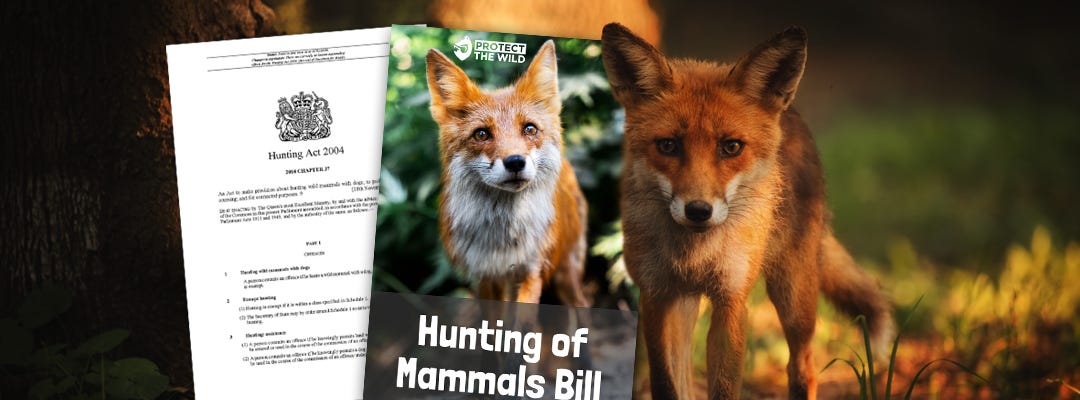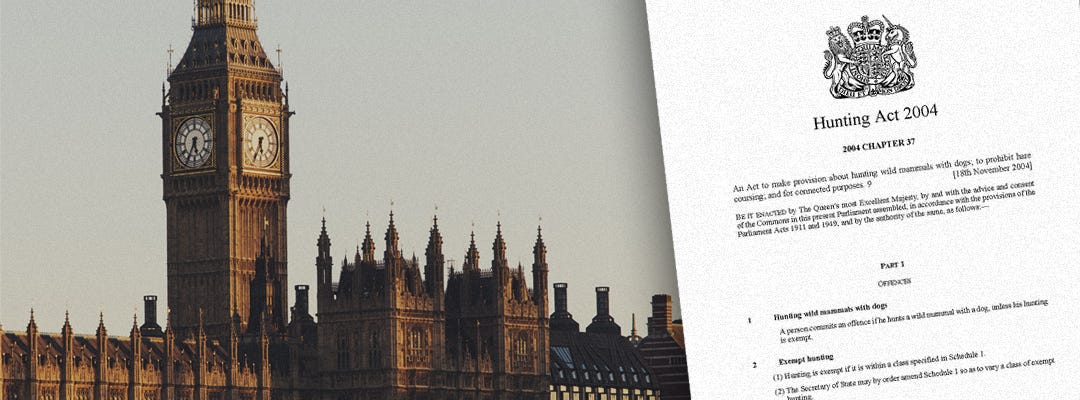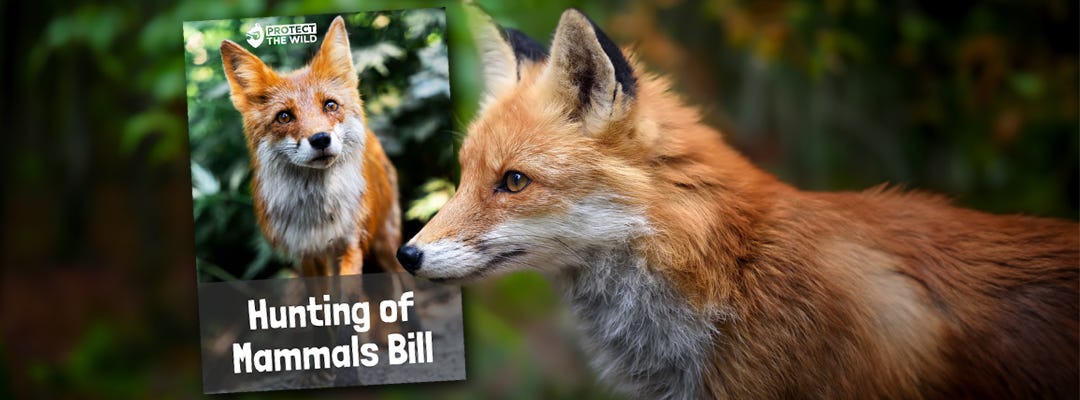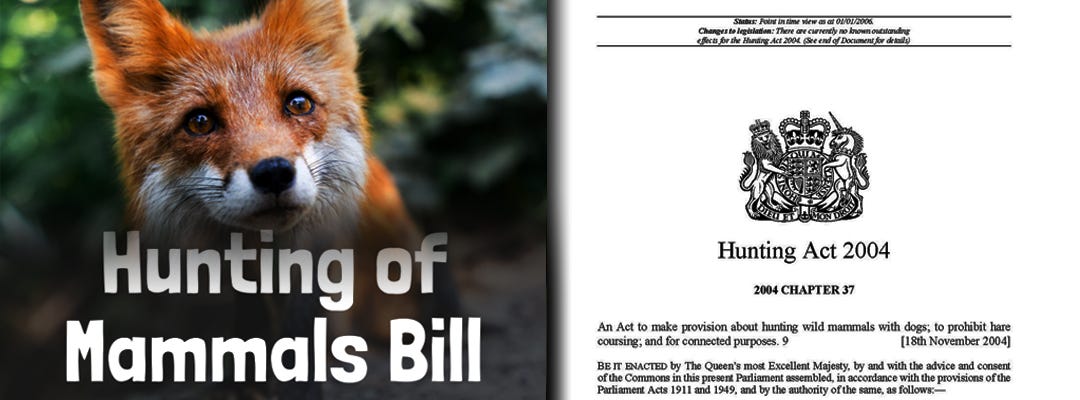The Hunting Act 2004 (HA) remains the key piece of legislation which addresses the illegal hunting of wild mammals in England and Wales.
The HA is now almost 20 years old and since its enactment has, time and time again, faced criticism as to its effectiveness; hunting has continued, both in the form of blatant illegality and under the guise of loopholes that have been stretched to the point to render the Act itself futile. Those that are held to account in the courts face little more than a slap on the wrist.
The findings we have collated (which form the basis of the report), have led us to propose the Hunting of Mammals Bill (HMB), which we believe close the loopholes and implement proper enforcement mechanisms.
Legally speaking - what is wrong with the HA?
The HA is only engaged if a person “intentionally” hunts a wild mammal, this has led to hunters claiming that the pursuit of a wild mammal was an accident.
However, trail hunting in principle is lawful and this continues to create confusion around the HA.
Trail hunting mimics traditional hunting and is therefore intended as an alternative. Those that engage in trail hunting are claiming to lay down animal based scents (usually fox urine) and dogs then follow that scent. The issue is that the location of the scent is unknown to the hunters in advance and tends to be put in areas where other animals are, meaning a “live” animal scent may be pursued instead.
. As we have seen from one of our key findings 46% of registered ‘trail hunts’ were caught chasing or killing foxes in the 2022/23 season.
To only require intention and not include recklessness has provided the perfect conditions to exploit the purpose of the ban.
In addition, there are exemptions to hunting, which are set out in the HA. Being able to rely on an exemption includes those who reasonably believed their hunting to be exempt.
In summary the exemptions include the following (although there is certain criteria attached to each) :
Stalking and flushing out of a wild mammal in order to prevent damage of some form (not exhaustive but can include birds/livestock/other property)
Use of dogs below ground to protect birds for shooting - permits stalking or flushing out for the purpose of preventing or reducing serious damage to game birds or wild birds (within the meaning of section 27 of the Wildlife and Countryside Act 1981 (c. 69)) which a person is keeping or preserving for the purpose of their being shot. In addition, flushing a wild mammal from cover is also exempt if for the purpose of enabling a bird of prey to hunt the wild mammal
Hunting rats and rabbits is also permitted as well as the retrieval of hares (that have been shot)
Hunting a wild mammal which has escaped or been released from captivity or confinement
Rescue of a wild mammal, where a hunter reasonably believes it is or may be injured
Hunting is also allowed for the purposes of research and observation
Exemptions are so wide that they are open to a huge amount of creative interpretation. Take, for example, the research and observation exemption (discussed earlier), this allows a wild mammal to be hunted for research purposes but also “in connection with the observation or study of the wild mammal”. There is no accompanying guidance as to what this might mean and whilst hunts may say, as did the DSSH, that such activity contributed to scientific research, there is no requirement for hunts to publish their findings or make them publicly available in any sense.
In 2020 Mark Hankinson (at the time Director of the Masters of Foxhounds Association) told a webinar that trail hunting can be used as a smokescreen in order for illegal hunting to take place. Mr Hankinson stated:
“It’s a lot easier to create a smokescreen if you’ve got more than one trail layer operating, and that is what it’s all about, trying to portray to the people watching that you’re going about your legitimate business.”
Essentially Mr Hankinson spoke to deliberate efforts to use trail hunting as a ruse to avoid prosecution under the HA. The webinar was later leaked by the Hunt Saboteurs Association. Mr Hankinson was convicted although his appeal was later overturned.
The Act’s effectiveness as the main piece of anti-hunting legislation for England and Wales is drastically compromised by its narrow focus, its wide exemptions, vague provisions and weak penalties (discussed further below). As a result of these limitations, wildlife remains inevitably and continually under threat.
How the HMB addresses the real problem of illegal hunting
As mentioned above, under the HA, if someone is accused of hunting illegally, they may claim that whilst their dog may have hunted a wild mammal, there is simply no proof that this is what they had intended.
This issue has been tackled in two key ways:
1) Recklessness has been included along with intention
Including a recklessness provision would seek to limit such scope here - it would enable hunts to be prosecuted not only when it can be proven that they did intend to hunt a wild mammal with dogs but also, if it can be proven they were reckless by not preventing their dogs from hunting a wild mammal. Adding such a provision would create a very practical benefit; by widening the hunter’s “mindset” - so that their recklessness as well as any intention could be scrutinised, which would inevitably lead to it being more feasible to prosecute and this, in turn, would likely deter any potential offenders.
The HMB includes “considerations” that could be taken into account, as to what could be relevant factors in determining if a person either intentionally or recklessly committed an offence. Such considerations would be whether:
A person encouraged a dog to hunt a wild mammal
A person failed to take reasonable steps to control a dog which is hunting a wild mammal
A person took such steps as were reasonable to avoid hunting a wild mammal
Reasonable efforts were made to control a dog which any reasonable person would, in the circumstances, consider to be hunting a wild mammal
The presence at any recreational hunt any person who has in their possession any equipment or animal which might reasonably be considered to be used for exempt hunting
An animal was killed during the course of a recreational hunt
This widening could lead to much more vigorous scrutiny of the behaviour that surrounds a hunt and aims for the behaviour of hunters to be assessed and really considered in detail.
2) Trail hunting has been expressly prohibited
As we have seen, trail hunting is said to be a smokescreen for illegal hunting. The HMB addresses this, specifically providing for the practice to be prohibited.
The connection between a hunting ban and the rise in trail hunting was recognised in Scotland when it introduced the Hunting with Dogs Act 2023, with the Scottish Environment Minister Màiri McAllan stating:
“As well as closing existing loopholes, I am seeking to prevent others opening. We have seen from recent events south of the border that trail hunting is sometimes being used as a cover for illegal hunting. We therefore plan to take pre-emptive action to prevent trail hunting becoming established in Scotland in order to reduce the risk of wild mammals being killed by dogs”
Land Owners and those Responsible for Land
The HMB also includes the possibility of not only land owners, but also those who are “responsible” for land to be prosecuted if they knowingly cause or permit land to be used, so that hunting offences can be commissioned. This widening seeks to avoid scenarios where, on technicalities, those who may have interests in land (though not strictly land owners) cannot be held accountable too for facilitating a hunt.
Use of a dog
The proposed HMB also adds a provision whereby a person “using a dog” for hunting a wild mammal even if the dog is “not under that person’s control or direction”. This addition helpfully widens the definition in an attempt to close down an existing loophole, which allows individuals to evade being found guilty of an offence merely due to assertions made that they were not, at a particular time, in control of a dog.
Police Powers & Sanctions
The HMB also focuses on the powers the police have where they reasonably believe a person is committing or has committed an offence. In addition to the HA currently allowing for search and seizure of vehicles, animals or other things, the HMB specifically makes reference to “mobiles phones”- bringing the same into sharp focus as being items where evidence may be found.
Under the HA, a body corporate as well as any relevant officer (director/manager/secretary - or a person purporting to be one of these) as well as any members (if the affairs of that body are managed by members) can be held liable. This is important because many hunts are registered organisations. However, under the HMB any “relevant organisation” and “responsible individuals” will also be bound by the HMB - essentially allowing for members of companies (as per S1 of the Companies Act 2006), limited liability partnerships, other partnerships and other bodies or associations to fall within the HMB’s remit. This widening of the pool of potential individuals being brought within the provisions of the HMB is essential to cover all those involved in the illegal hunting and to act as a deterrent to the same.
At present, under the HA there is also provision for the forfeiture of any dog or hunting article which was either used in the commission of a relevant offence or which was in the possession of a person convicted at the time of their arrest. There are powers for dogs or articles to then be disposed/destroyed which again can lead to the destruction of more animals. Under the HMB, the forfeiture clause is only in relation to vehicles or hunting articles. There is a separate provision which would give the courts’ power to “deprive” a hunt of a dog (or horses) used in the commission of a relevant offence but with conditions to ensure their welfare. Whilst there is the power for the destruction of a dog (or horse), this could only happen if evidence provided by a veterinary surgeon concludes it would be in the interests of the animal.
In a similar vein, the HMB would enable courts to “disqualify” those who commit hunting offences from owning or transporting animals, working with animals, providing a service related to animals or taking possession/charge of any animal. And where necessary the HMB also provides for a “seizure order” for any animal kept by anyone who is already subject to a disqualification order. This not only prevents illegal hunting with those animals, but it will also further safeguard the welfare of animals.
Finally, and very importantly, the HMB removes all hunting exemptions, which not only saves the lives of those mammals actively pursued and hurt during any given hunt, but prevents the ability to exploit these exemptions and create gaping loopholes.
How do the penalties and the enforcement provisions of the HA and HMB compare?
Offences under the HA are “summary only” offences, this means they are considered the least serious type of criminal offence, in addition successful convictions under the HA can only result in fines, which are capped at £5,000. Despite this relatively low cap where successful prosecutions have been brought, fines have generally been in the hundreds rather than the thousands of pounds.
The HMB seeks to change this by proposing that offences are now either way offences, meaning they can be both summary and indictable, a more serious type of offence. The penalties include on summary conviction, a term of imprisonment not exceeding 12 months and/or an unlimited fine, and on indictment, a term of imprisonment not exceeding 5 years and/or an unlimited fine.
The proposals in the HMB mirror the essence of the Animal Welfare Act 2006 (AWA) - the UK’s key piece of legislation that governs animal welfare. For the most serious offences under the AWA, the term of imprisonment is up to 5 years and/or an unlimited fine, it seems only logical to instil that same rationale here when we are dealing with significant animal cruelty.
To put this into context, if found guilty of illegal hunting which resulted in the death of a wild mammal (which will undoubtedly have caused the hunted animal a great deal of pain, suffering and injury) at present, under the HA a person could only be required to pay a maximum fine of up to £5,000. Whereas, take a person convicted of causing pain, suffering or injury to an animal under the AWA, they could face an unlimited fine and/or a period of up to five years imprisonment.
The HA and AWA are clearly at odds with one another and the HMB seeks to bring anti-hunting legislation in line with the AWA.
If wildlife is to be genuinely protected, there must be robust legislation which includes significant deterrents. The HMB seeks to protect all manners of wildlife by implementing a “proper hunting ban” and ensuring that those who choose to breach it can be properly and meaningfully held to account.







